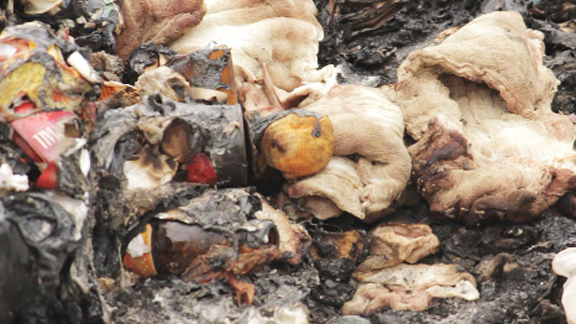The callous dumping of hospital waste near Red Village, on the Essequibo Coast is continuing, the AFC said yesterday, while announcing that it will write to the Pan American Health Organisation (PAHO) and other relevant bodies about the “disaster” in the making.
Nearly one year after the residents’ plight was highlighted in this newspaper, AFC Chairman Nigel Hughes told reporters yesterday that the party was appalled to see, when on a visit to the village, that the situation had not changed.
He said they saw syringes, needles, bloody gauze and human body parts on the heap dumped by the Suddie Hospital, a stone’s throw away from the village. What was even more frightening was when they learnt from villagers that children during play, pick up the syringes and chase each other.
“There was an open dumpsite in which there were all forms of medical waste, blood strewn gauze, bones, human bones and remains, syringes something that resembled post operative pregnancy body parts which the residents described as the afterbirth open to the public,” Hughes said.

“It is in a location, which is not fenced. It was not buried, it was not isolated and it was literally 60 metres away from Red Village. The dogs would go to the dumpsite and would pick up human remains and bring it back to the village… the children would pick up syringes and be threatening to bore each other, in some sort of game that they play,” he added.
Hughes explained that his party sees the action by the Suddie Hospital as a medical crisis given the many dangers it poses and as a result it will write to PAHO and other agencies highlighting the residents’ concerns. “This is a medical crisis. It is in total violation of the law. The Environmental Protection Act specifically prohibits this and to think that the Suddie Hospital would be involved in such flagrant flouting of the law,” he stated.
Several efforts to contact Minister of Health Dr Bheri Ramsaran yesterday proved futile.
“We, the AFC, intend to alert PAHO as well as those agencies not only with the disposal of waste but also the required compliance with the most minimal basic international standard for the establishment of dumpsites, particularly for the disposal of medical wasted,” Hughes declared.
“We consider this a national threat… this is a disaster waiting to happen which requires immediate urgent action,” he added.
Hughes also raised alarm over the potential health hazards that seepages from the dump into the main canal used for domestic purposes could pose. He explained that when it rains, the water runs into the canal but residents had no choice as that was their main source of water, since there is no well in the area. He informed that there is also no electricity.
Little Red Village is a community built entirely by the non-governmental organisation Food For The Poor (FFTP) in collaboration with the Roetheli family of the USA. Prior to its establishment, the village, also known as Sandpit, was very bushy and the villagers lived in primitive and poverty stricken conditions.
However, FFTP had noted the need for housing in the area, where many families lived in shacks. After meetings with the people of the area, an initiative was taken to clear the land, following which it was decided that each house lot would be an approximate size of 50 ft by 100 ft.
Villagers were then mandated to purchase the land from government and because of their circumstances, FFTP negotiated with the government for a minimum price, which was settled on at $66,000 per house lot. Through a collaborative effort with the Roetheli family 100 houses were built.




